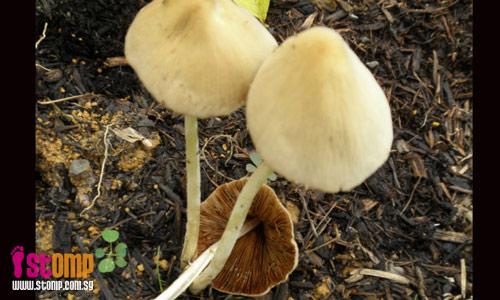
Knowing the difference between edible and poisonous mushrooms can save your life, says a STOMPer, who spotted these wild and poisonous mushrooms in a garden.
He warns that poisonous mushrooms usually turn red when boiled and reminds everyone to be aware of what they are consuming.
In an email, the STOMPer says:
"This wild mushroom (pictured above) is highly poisonous and it grows freely beneath your garden plants. It sprouts up early in the morning and by late afternoon it shrivels and droops at an angle.
"Mushrooms are the fruits of fungus. The fungus itself is a net of threadlike fibres called a mycellium, growing in soil and decaying matter.
"The function of a mushroom is to produce spores which are the "seeds" of the fungus.
"The spores fall off to blow away on the wind or be carried by animals, water or insects. If a spore lands in a suitable spot, it germinates and grows into a new mycellium.
"Some mushrooms are extremely poisonous and are often fatal if ingested by humans. They contain organic toxins that destroy cells in the central nervous system, blood vessels, kidneys and liver.
"The mushrooms sold in our wet markets are the shiitake mushroom and the oyster mushroom. The shiitake is dark brown in colour and has an umbrella shaped cap and tan gills. The oyster mushroom resembles a fan and is usually beige brown in colour. It can be eaten raw in salads.
"Poisonous mushrooms are brightly coloured, usually red or yellow. Poisonous mushrooms will turn slightly red when boiled.
"Such simple knowledge may be a matter of life and death for you if you are not careful.
"Here is a picture of an edible mushroom."
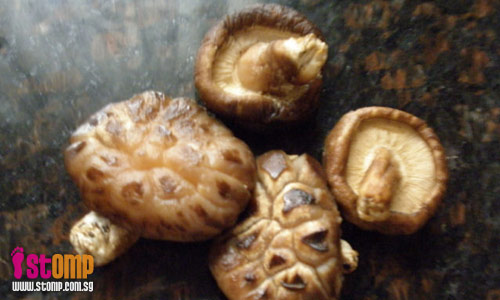
I'm afraid that the person's assertion that poisonous mushrooms will turn red when boiled is complete nonsense. There are no hard and fast rules where it comes to identifying poisonous mushrooms. There are poisonous mushrooms which closely resemble perfectly edible species, and as far as I know, there is nothing in the literature which states that poisonous mushrooms turn red when boiled. The Wikipedia page on mushroom poisoning has a list of folk traditions on how to differentiate poisonous mushrooms from edible ones, and it would be extremely foolhardy to depend solely on such dubious advice. Dispensing erroneous advice that is not backed up by any actual scientific evidence is downright irresponsible.
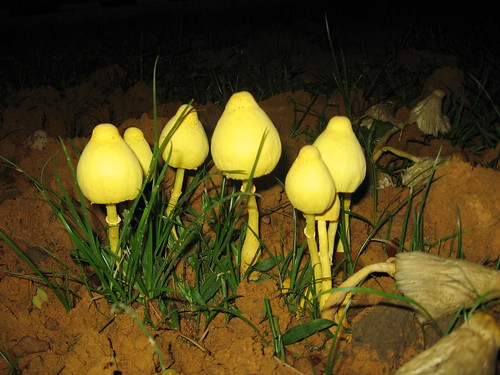
(Photo by Zetrax)
Identifying mushrooms requires close and intimate knowledge of the mushroom species that may be found growing in a particular geographic area. Such knowledge does not come easily, and typically requires lots of reading, consultation with experts, and spending time out in the field examining the various species of mushrooms.
Like almost every other taxonomic group, fungi are not exactly the most well-studied organisms around, and it is more than likely that in any given area, there are mushroom species that have yet to be scientifically described, let alone tested for edibility.
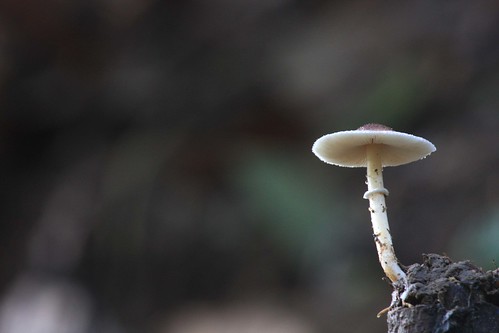
(Photo by naturecord)
Comprehensive identification guides have been written for many parts of the world, enabling mushroom pickers to confidently identify which ones are safe to eat and which ones spell a trip to the emergency room, although as far as I know, such a guide has not been published for Singapore's mushroom species; I think the closest equivalent would be A Guide to Tropical Fungi, which was published in 1990. The usefulness of these guidebooks is very much constrained by geography; the mushrooms of North America and Europe are relatively well-known compared to those found in tropical South-east Asia, and a guide written specifically for people living in the northern United States of America would definitely be all but useless in trying to identify mushrooms in Singapore. Even with a guidebook in hand, identification of mushroom can be tricky, and not every mushroom encountered in the wild might be listed in a guidebook. Because fungal spores can be dispersed over great distances, it is possible to encounter a mushroom species not typically known to occur within a particular area. And as the climate changes, and the distribution of certain species shifts in response to these changes, it is likely that a guidebook that was written several decades ago would become obsolete to some degree.
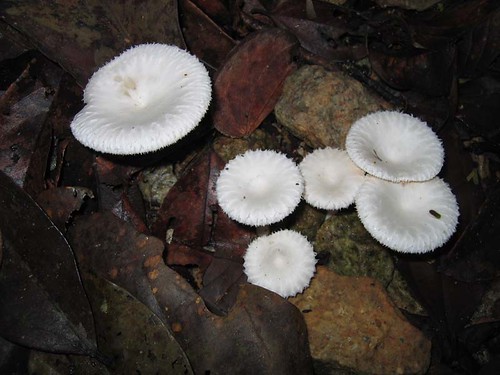
(Photo by Miko 姫)
Here's an excerpt from Poisonous mushrooms of the northern United States and Canada, which gives extremely valuable advice in making sure that one does not unwittingly pick and consume poisonous mushrooms.
No single test or rule can be used to determine the edibility of any mushroom or any fungus. Each species must be carefully studied and learned so that edible species can be separated from those that are poisonous. If you are unfamiliar with the structure and identification of fungi, study reliable literature, enroll in a course on mushroom identification, or join a mushroom club or society. As you learn to identify mushrooms and other fungi, have each identification checked by an authority so you know it is correct. In other words learn something about the subject before you start collecting for food. After some of the common species are learned, additional ones can be studied and added to those you already know. In a few seasons you will be able to identify and collect one or more edible species.
Some general tests for determining the edibility of fungi are strictly superstition and are entirely unreliable. One of these is the belief that garlic cloves or silver coins turn blue or black when they are cooked in the same pan with poisonous mushrooms. Nevertheless, there are several useful guidelines that can be followed, which greatly reduce the risk of being poisoned. Some of these guidelines that make collecting fungi for food a less dangerous hobby are listed below.
- Be absolutely sure of the identification of the species you are collecting for food.
- Collect each specimen carefully and remove the entire fruit body from the substratum to check its identification. Several species of mushroom may grow together and it is easy to become careless and make a mistake, especially in a good season.
- Collect only one species at a time. If you collect more than one species, keep each in a separate container or package.
- Do not collect overmature or spoiled fruit bodies. Only fresh, young specimens are good for food. As mushrooms age they often decay and are not suitable for eating.
- Keep specimens clean by removing excess soil and debris, but do not cut away parts of the mushroom, or other identifying features. Note the substratum and habitat where the fruit bodies are collected, and be sure of the location.
- Collect and transport specimens in a sturdy, well-aired container, such as a market basket.
- On reaching home, put specimens in a cool, dry place, preferably a refrigerator. If specimens are wet or soiled, place or wrap them them in a dry, clean package or container.
- Clean and process or eat the specimens as soon as possible after you arrive home. Mushrooms and other fungi deteriorate rapidly and should not be kept longer than 24 hours before processing or eating. As you prepare the specimens, cut each lengthwise and check for spoilage or insect damage.
- Do not eat wild mushrooms raw.
- Eat only one kind of mushroom at a time. Do not overeat.
- The first time you sample a species of mushroom, eat only a small amount and observe your reaction to it. Save a few intact fresh specimens for identification in case you become ill.
- Learn as much as you can about the various kinds of poisoning and the related symptoms.
- If you do experience symptoms of poisoning, empty your stomach as soon as possible and seek medical aid.
- Report all poison cases. Your experiences may prevent others from making similar mistakes.

(Photo by redpolkadot)
I don't have a copy of A Guide to Tropical Fungi, and have never browsed through it before, so I have no idea how much attention is given to differentiating poisonous and edible species found in Singapore. At the same time, however, I'm sure that the following piece of advice works just as well: Don't pluck and eat wild mushrooms. You can't get any more straightforward than that.